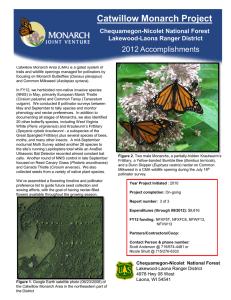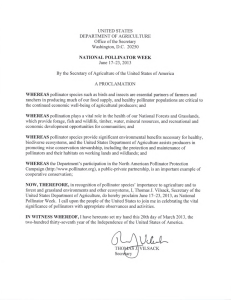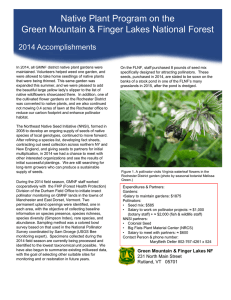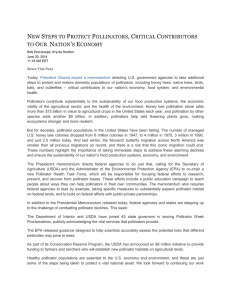Pollinator Education Resources - Million Pollinator Garden Challenge
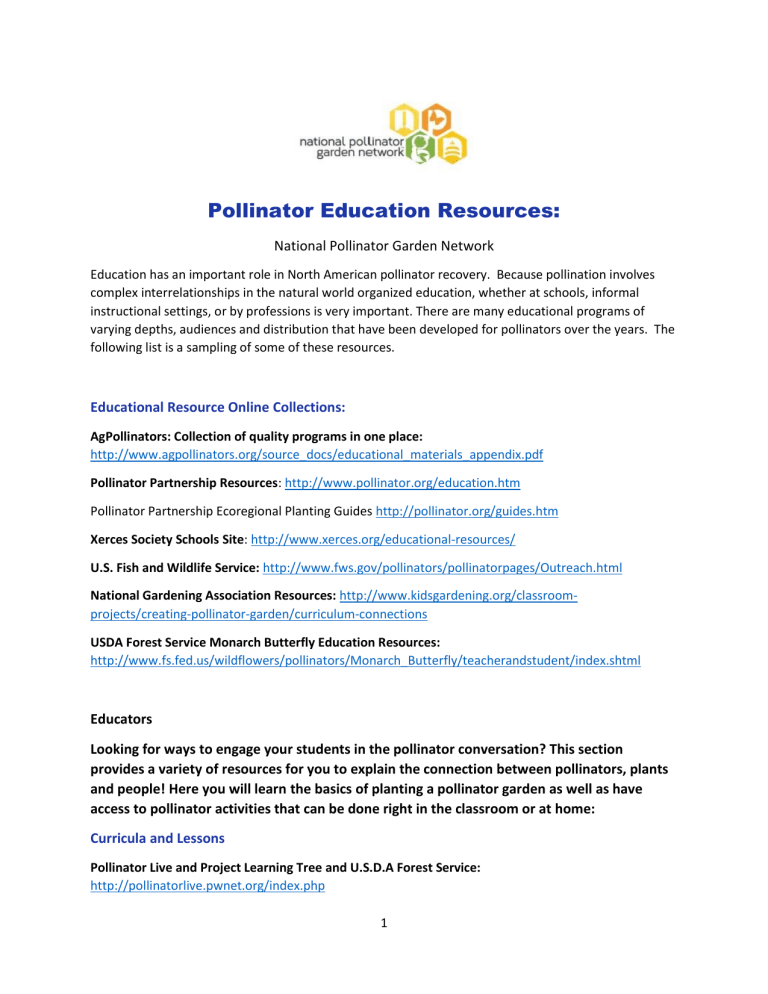
Pollinator Education Resources:
National Pollinator Garden Network
Education has an important role in North American pollinator recovery. Because pollination involves complex interrelationships in the natural world organized education, whether at schools, informal instructional settings, or by professions is very important. There are many educational programs of varying depths, audiences and distribution that have been developed for pollinators over the years. The following list is a sampling of some of these resources.
Educational Resource Online Collections:
AgPollinators: Collection of quality programs in one place: http://www.agpollinators.org/source_docs/educational_materials_appendix.pdf
Pollinator Partnership Resources : http://www.pollinator.org/education.htm
Pollinator Partnership Ecoregional Planting Guides http://pollinator.org/guides.htm
Xerces Society Schools Site : http://www.xerces.org/educational-resources/
U.S. Fish and Wildlife Service: http://www.fws.gov/pollinators/pollinatorpages/Outreach.html
National Gardening Association Resources: http://www.kidsgardening.org/classroomprojects/creating-pollinator-garden/curriculum-connections
USDA Forest Service Monarch Butterfly Education Resources: http://www.fs.fed.us/wildflowers/pollinators/Monarch_Butterfly/teacherandstudent/index.shtml
Educators
Looking for ways to engage your students in the pollinator conversation? This section provides a variety of resources for you to explain the connection between pollinators, plants and people! Here you will learn the basics of planting a pollinator garden as well as have access to pollinator activities that can be done right in the classroom or at home:
Curricula and Lessons
Pollinator Live and Project Learning Tree and U.S.D.A Forest Service: http://pollinatorlive.pwnet.org/index.php
1
Montana Department of Agriculture : (Sample of state-based program) http://agr.mt.gov/agr/Programs/AgClassroom/k-8projects/
Natures Partners: The Pollinator Partnership : http://www.pollinator.org/nappc/PDFs/curriculum.pdf
Monarchs in the Classroom: Cornell Lab of Ornithology : http://www.birds.cornell.edu/citscitoolkit/projects/umn/monarchsintheclassroom/
Pollinator Partnership: BeeSmart TM School Garden Kit: http://pollinator.org/beesmart_about.htm
The Power of Pollinators: Xerces Society : http://www.xerces.org/wpcontent/uploads/2008/09/PowerOfPollinators_lr_sec.pdf
Next Generation Science Standards : http://www.nextgenscience.org/2ls2-ecosystems-interactionsenergy-dynamics
An example of Next NGSS Lesson Plan by S and K : http://scienceandkidsactivities.com/Science_and_Kids_Activities/NGSS_Assessments_Lessons/Pages/N
GSS_G2_Pollination_Seed_Dispersal.html
4H Butterfly Curriculum: https://www.flmnh.ufl.edu/wings/
National Environmental Education Foundation Pollinator Guide https://www.neefusa.org/resource/pollinator-backyard-activity-guide
University of Minnesota Monarch Lab's Education & Gardening site : The Monarch Lab provides an abundance of educational tools, workshops, and expertise through a variety of different programs aiming to promote and facilitate inquiry-based education through original curricula and research opportunities, many of which involve schoolyard gardens.
Journey North resources : Journey North has a wide variety of monarch resources ranging from slideshows to activities to infographics about every stage of the monarch migration and life cycle.
Flight of the Butterflies classroom activities : Curricula and activities based on the Flight of the Butterflies film.
Examples of School Garden Programs:
National Wildlife Federation Schoolyard Habitats : https://www.nwf.org/How-to-Help/Garden-for-
Wildlife/Schoolyard-Habitats.aspx
National Gardening Association School gardening: http://www.kidsgardening.org/school-gardening
Captain Planet Foundation Learning Gardens : http://captainplanetfoundation.org/learning-garden/
Pollinator Partnership: Your school and pollinators : http://www.pollinator.org/PDFs/NAPPC.Schools.broch.pdf
2
Monarch Waystation Program: Monarch Watch: http://www.monarchwatch.org/waystations/
U.S. Botanic Garden School Garden Wizard: http://www.schoolgardenwizard.org/
Wild Ones Seeds for Education (SFE) program http://www.wildones.org/?s=SFE
MJV Schoolyard Gardens Fact Sheet : one specific fact sheet I thought would be of use.
Examples of Pollinator Citizen Science Programs
Bumble Bee Watch : http://www.bumblebeewatch.org/
Xerces Bee Monitoring Protocol : http://www.xerces.org/wpcontent/uploads/2014/09/StreamlinedBeeMonitoring_web.pdf
Journey North : Monarch Butterflies: http://www.learner.org/jnorth/monarch/index.html
Pennsylvania Pollinator Monitoring Guide : (Sample of state program): http://www.xerces.org/download/pdf/PA_Xerces%20Guide.pdf
Ecological Society of America: Pollination Toolkit : http://esa.org/ecoservices/
Monarch Watch : http://www.monarchwatch.org/
Minnesota Monarch Larva Monitoring : http://www.mlmp.org/
Wild Ones Citizen Science Monitoring http://www.wildones.org/?s=citizen+science
Examples of Training and Education for Professionals
NAPPC Eco-regional Planting Guides: Pollinator Partnership: http://www.pollinator.org/guides.htm
Pollinator Friendly Parks : Xerces: http://www.xerces.org/guidelines-pollinator-friendly-parks/
Pollinator Friendly Roadsides: http://www.xerces.org/pollinator-conservation-roadsides/
Creating a Pollinator Friendly Landscape: Oklahoma Kerr Center : http://kerrcenter.com/conservation/pollinator-friendly-landscape/
Bay Friendly Landscaping and Gardening: California : https://www.bayfriendlycoalition.org/Landscapeprofessional.shtml
Connecting farmers, landscapers and beekeepers to protect pollinators: North Carolina: Cooperative
Extension: https://entomology.ces.ncsu.edu/2015/08/connecting-farmers-landscapers-andbeekeepers-to-protect-pollinators/
Chesapeake Conservation Landscaping Council : http://www.chesapeakelandscape.org/tag/pollinators/
3
Missouri Native Plants for Landscapers Guide : http://mdc.mo.gov/sites/default/files/resources/2010/05/nativeplantsrevision_2012_07web.pdf
Ontario Horticultural Association Guide to Creating Pollinator Patches http://www.gardenontario.org/subdomains/conservation/resources/guide.pdf
Department of Energy & Environment Pollinator Gardening http://doee.dc.gov/pollinators
Sustainable Sites Initiative™ (SITES™) , an interdisciplinary partnership led by the American Society of
Landscape Architects (ASLA), the Lady Bird Johnson Wildflower Center at The University of Texas at
Austin and the United States Botanic Garden to transform land development and management practices through the nation’s first voluntary guidelines and rating system for sustainable landscapes, with or without buildings. http://www.sustainablesites.org/
4

